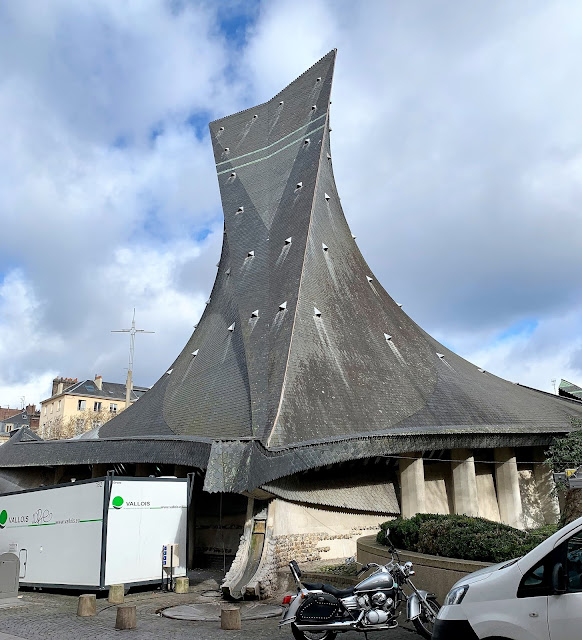Rouen had an important role during the Hundred Years' War between the English kings and the French kings (1337-1453). One episode involved the trial and execution on May 30, 1431 of Joan of Arc. The English and the Burgundians were afraid of Joan's ability to inspire the French king and military forces. So, after capturing her during a battle, she was transported to Rouen and tried for repeated heresy. The outcome, however, was pre-ordained and she was convicted and burned alive.
Big mistake. Joan of Arc was considered a martyr and became a lasting symbol of French independence. Eventually canonized in 1920, Sainte Jeanne d'Arc is a patron saint of France. (You can learn more about Joan of Arc's life by clicking here.)
Below, a tall cross marks the place in Rouen where Joan of Arc was executed.
Next to the cross stands a tall, modern church dedicated to Joan of Arc, completed in 1979, L'église Sainte-Jeanne-d'Arc. The church resembles a dragon, reminiscent of the Norman history of Rouen, when Nordic invaders conquered the region using their viking drakar, dragon boats. In the photo below, we see the dragon's tall head and its gaping mouth (next to the white truck).
Below is a photo of the entire exterior of the church with the dragon's head and long body.
The nautical theme continues inside the wooden church with its curved ceiling resembling the ribs of a ship's hull.
The church's interior is ultra-modern with a semi-circular shape and very tall stained-glass windows.
Below is a bust in the church depicting Joan of Arc.

In Rouen, we learned a lot about Joan of Arc. We also learned they know doughnuts in Rouen. So, if you are a glutton, you could eat your fill.
Ironically, they also know vacuum cleaners in Rouen. Check out the "Glutton" below.
Thanks for visiting Rouen with us.
Next Up: Honfleur











No comments:
Post a Comment